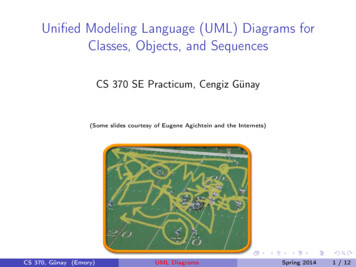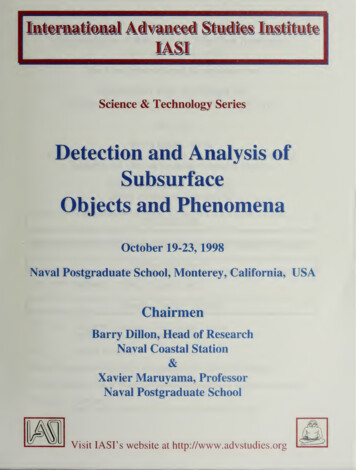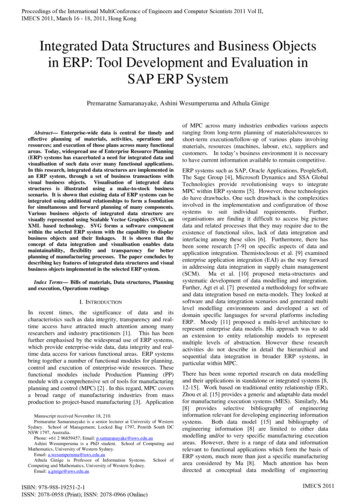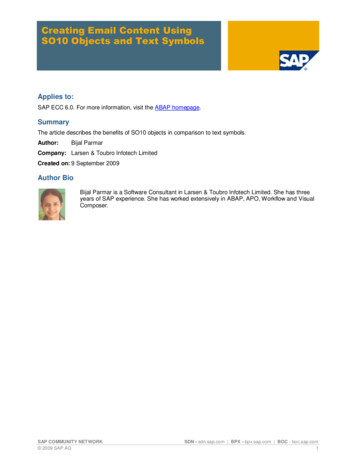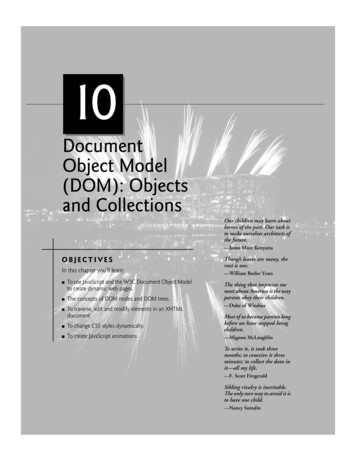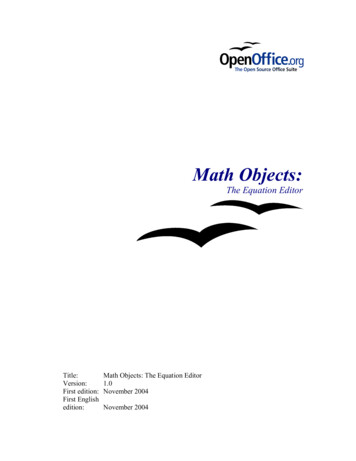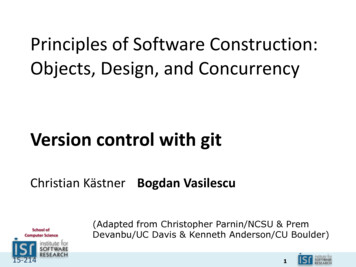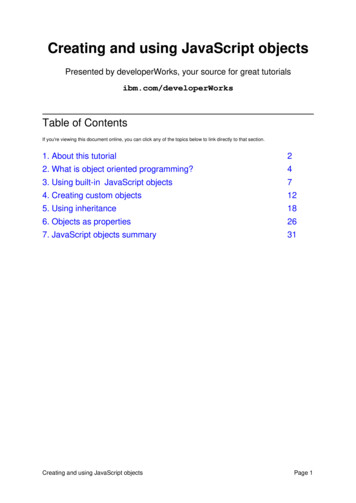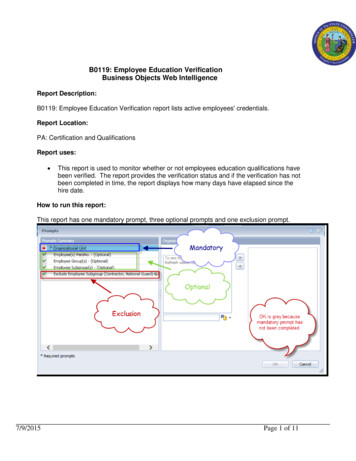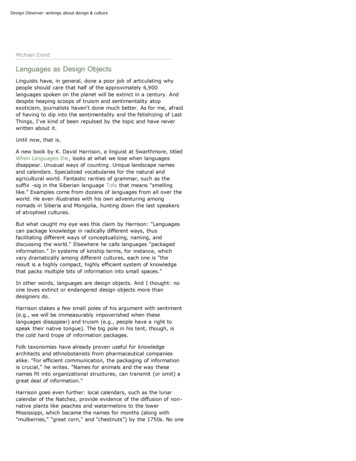
Transcription
Classes and objectsclass Student {string name;int id;float gpa;public:Student();Student(string, int, float);void inputStudent();void outputStudent();float getGpa();void setGpa();};Save the class as Student.hCreate Student.cpp#include “Student.h”resolution operatorStudent :: Student(){name “”;id 0;gpa 0.0;}Student :: Student(string name, int i, float g) {this.name name;id I;gpa g;}Student :: inputStudent() {cin name;cin id;cin gpa;}Student:: outputStudent() {cout name endl;cout id endl;cout gpa endl;}float Student :: getGpa() {return gpa;}
void Student :: stGpa(float f) {gpa f;}Implement the main function:int main () {Student stud1; // call Student()Student stud2(“John, 123, 3.5); // call );stud2.setGpa(3.7);cout stud2.getGpa();}InheritanceDerived class: modifier{(publicprotectedprivate)}Base SubclassProtectedpublic
classprivatemodifierSubclassPrivateprivateSingle inheritanceclass Shape {protected:int x;int y;public:void setxy(int x1, int y1) {x x1;y y1;}};
class Rectangle : public Shape {float w;float h;public:float area() {return w*h;}Rectangle(float w1, float h1) : Shape() {w w1;h h1;}void displayRec() {cout “x “ x endl;cout “y “ y endl;cout “ Area “ area() endl;}};In main:Rectangle r1 (10.0, 20.0);r1.setxt(3,5);r1.displayRec(); // x 3, y 5, area 200Initialize data numbers in a constructorclass Distance {int feet;float inches;public:Distance() {feet 0;inches 0.0;}OR:Distance() : float (0), inches(0.0){}Distance (int f, float i){feet f;inches I;}OR:
Distance(int f, float i) : feet(f), inches(i){}Distance (int f, float i){feet f;inches I;}Constructors in multiple inheritanceClass Type {string dimension;string grade;public:Type(): dimension(“N/A”) { }Type(string d, string g): dimension(d), grade(y) { }TypeDistanceMultiple InheritanceLumberclass Lumber: public Distance, public Typeprivate:int quantity;float price;public:Lumber(): Distance(), Type() {quantity 0;price 0.0;}OR:Lumber(): Distance(), Type(), quantity(0), price(0.0) {}
In main:Lumber l1();Lumber(int f, float i, string d, string g, int q, float p): Distance(f, i), Type(d, g), quantity(0), price(0.0)Distance{TypeLumber}Member functions in multiple inheritanceStudentEmployeeManagesclass Student{private:string school,string degree;public:void getData() {cin school;cin degree;}void putData() {cout school endl;cout degree endl;}};class Employee {string name;int id;public:void getData() {cin name;cin id;
}void putData(): const { // Cannot change any values inside the function.cout name endl;cout id endl;}};class Manager: private Employer, private Student {private:string title;float dues;public:void getData() {Employee:: getData();Student:: getData();cin title;cin dues;}void putData() {Employee:: putData();Student:: putData();cout title endl;}};Overview of InheritanceInheritance is the capability of one class to acquire properties and characteristics from another class. Theclass whose properties are inherited by other class is called the Parent or Base or Super class. And, theclass which inherits properties of other class is called Child or Derived or Sub class.Inheritance makes the code reusable. When we inherit an existing class, all its methods and fieldsbecome available in the new class, hence code is reused.NOTE : All members of a class except Private, are inheritedPurpose of Inheritance1. Code Reusability2. Method Overriding (Hence, Runtime Polymorphism.)3. Use of Virtual KeywordBasic Syntax of Inheritance
class Subclass name : access mode Superclass nameWhile defining a subclass like this, the super class must be already defined or atleast declared before thesubclass declaration.Access Mode is used to specify, the mode in which the properties of superclass will be inherited intosubclass, public, privtate or protected.Inheritance Visibility ModeDepending on Access modifier used while inheritance, the availability of class members of Super class inthe sub class changes. It can either be private, protected or public.1) Public InheritanceThis is the most used inheritance mode. In this the protected member of super class becomes protectedmembers of sub class and public becomes public.class Subclass : public Superclass2) Private InheritanceIn private mode, the protected and public members of super class become private members of derivedclass.class Subclass : Superclass // By default its private inheritanceTable showing all the Visibility ModesDerived ClassDerived ClassDerived ClassBase classPublic ModePrivate ModeProtected ModePrivateNot InheritedNot InheritedNot ublicPrivateProtectedTypes of InheritanceIn C , we have 5 different types of Inheritance. Namely,1. Single Inheritance2. Multiple Inheritance3. Hierarchical Inheritance
4. Multilevel Inheritance5. Hybrid Inheritance (also known as Virtual Inheritance)Single InheritanceIn this type of inheritance one derived class inherits from only one base class. It is the most simplest formof Inheritance.Multiple InheritanceIn this type of inheritance a single derived class may inherit from two or more than two base classes.Hierarchical InheritanceIn this type of inheritance, multiple derived classes inherits from a single base class.
Multilevel InheritanceIn this type of inheritance the derived class inherits from a class, which in turn inherits from some otherclass. The Super class for one, is sub class for the other.Hybrid (Virtual) InheritanceHybrid Inheritance is combination of Hierarchical and Mutilevel Inheritance.
Order of Constructor CallBase class constructors are always called in the derived class constructors. Whenever you create derivedclass object, first the base class default constructor is executed and then the derived class's constructorfinishes execution.Points to Remember1. Whether derived class's default constructor is called or parameterised is called, base class's defaultconstructor is always called inside them.2. To call base class's parameterised constructor inside derived class's parameterised constructo, wemust mention it explicitly while declaring derived class's parameterized constructor.Base class Default Constructor in Derived class Constructorsclass Base{ int x;public:Base() { cout "Base default constructor"; }};class Derived : public Base{ int y;public:Derived() { cout "Derived default constructor"; }Derived(int i) { cout "Derived parameterized constructor"; }};int main(){Base b;Derived d1;Derived d2(10);
}You will see in the above example that with both the object creation of the Derived class, Base class'sdefault constructor is called.Base class Parameterized Constructor in Derived class ConstructorWe can explicitly mention to call the Base class's parameterized constructor when Derived class'sparameterized constructor is called.class Base{ int x;public:Base(int i){ x i;cout "Base Parameterized Constructor\n";}};class Derived : public Base{ int y;public:Derived(int j) : Base(j){ y j;cout "Derived Parameterized Constructor\n";}};int main(){Derived d(10) ;getch();}Output:Base Parameterized ConstructorDerived Parameterized ConstructorWhy is Base class Constructor called inside Derived class ?Constructors have a special job of initializing the object properly. A Derived class constructor has accessonly to its own class members, but a Derived class object also have inherited property of Base class, andonly base class constructor can properly initialize base class members. Hence all the constructors arecalled, else object wouldn't be constructed properly.Constructor call in Multiple InheritanceIts almost the same, all the Base class's constructors are called inside derived class's constructor, in thesame order in which they are inherited.class A : public B, public C
In this case, first class B constructor will be executed, then class C constructor and then class Aconstructor.Upcasting in C Upcasting is using the Super class's reference or pointer to refer to a Sub class's object. Or we can saythat, the act of converting a Sub class's reference or pointer into its Super class's reference or pointer iscalled Upcasting.class Super{ int x;public:void funBase() { cout "Super function"; }};class Sub : public Super{ int y;};int main(){Super* ptr; // Super class pointerSub obj;ptr &obj;Super &ref; // Super class's referenceref obj;}The opposite of Upcasting is Downcasting, in which we convert Super class's reference or pointer intoderived class's reference or pointer. We will study more about Downcasting later
Functions that are never Inherited Constructors and Destructors are never inherited and hence never overrided. Also, assignment operator is never inherited. It can be overloaded but can't be inherited by subclass.Inheritance and Static Functions1. They are inherited into the derived class.2. If you redefine a static member function in derived class, all the other overloaded functions in baseclass are hidden.3. Static Member functions can never be virtual. We will study about Virtual in coming topics.Hybrid Inheritance and Virtual ClassIn Multiple Inheritance, the derived class inherits from more than one base class. Hence, in MultipleInheritance there are a lot chances of ambiguity.class A{ void show(); };class B:public A {};class C:public A {};class D:public B, public C {};int main(){D obj;obj.show();}In this case both class B and C inherits function show() from class A. Hence class D has two inheritedcopies of function show(). In main() function when we call function show(), then ambiguity arises, becausecompiler doesn't know which show() function to call. Hence we use Virtual keyword while inheriting class.class B : virtual public A {};class C : virtual public A {};class D : public B, public C {};Now by adding virtual keyword, we tell compiler to call any one out of the two show() funtions.
Hybrid Inheritance and Constructor callAs we all know that whenever a derived class object is instantiated, the base class constructor is alwayscalled. But in case of Hybrid Inheritance, as discussed in above example, if we create an instance of classD, then following constructors will be called : before class D's constructor, constructors of its super classes will be called, hence constructors ofclass B, class C and class A will be called. when constructors of class B and class C are called, they will again make a call to their super class'sconstructor.This will result in multiple calls to the constructor of class A, which is undesirable. As there is a singleinstance of virtual base class which is shared by multiple classes that inherit from it, hence the constructorof the base class is only called once by the constructor of concrete class, which in our case is class D.If there is any call for initializing the constructor of class A in class B or class C, while creating object ofclass D, all such calls will be skipped.PolymorphismPolymorphism means having multiple forms of one thing. In inheritance, polymorphism is done, by methodoverriding, when both super and sub class have member function with same declaration bu differentdefinition.Function OverridingIf we inherit a class into the derived class and provide a definition for one of the base class's functionagain inside the derived class, then that function is said to be overridden, and this mechanism iscalled Function OverridingRequirements for Overriding1. Inheritance should be there. Function overriding cannot be done within a class. For this we require aderived class and a base class.2. Function that is redefined must have exactly the same declaration in both base and derived class, thatmeans same name, same return type and same parameter list.
Example of Function Overridingclass Base{public:void show(){cout "Base class";}};class Derived:public Base{public:void show(){cout "Derived Class";}}In this example, function show() is overridden in the derived class. Now let us study how these overriddenfunctions are called in main() function.Function Call Binding with class ObjectsConnecting the function call to the function body is called Binding. When it is done before the program isrun, its called Early Binding or Static Binding or Compile-time Binding.class Base{public:void shaow(){cout "Base class\t";}};class Derived:public Base{public:void show(){cout "Derived Class";}}int main(){Base b;//Base class object
Derived d; //Derived class objectb.show(); //Early Binding Ocuursd.show();}Output : Base class Derived classIn the above example, we are calling the overrided function using Base class and Derived class object.Base class object will call base version of the function and derived class's object will call the derivedversion of the function.Function Call Binding using Base class PointerBut when we use a Base class's pointer or reference to hold Derived class's object, then Function callBinding gives some unexpected results.class Base{public:void show(){cout "Base class";}};class Derived:public Base{public:void show(){cout "Derived Class";}}int main(){Base* b;//Base class pointerDerived d; //Derived class objectb &d;b- show(); //Early Binding Occurs}Output : Base class
In the above example, although, the object is of Derived class, still Base class's method is called. Thishappens due to Early Binding.Compiler on seeing Base class's pointer, set call to Base class's show() function, without knowing theactual object type.Virtual FunctionsVirtual Function is a function in base class, which is overrided in the derived class, and which tells thecompiler to perform Late Binding on this function.Virtual Keyword is used to make a member function of the base class Virtual.Late BindingIn Late Binding function call is resolved at runtime. Hence, now compiler determines the type of object atruntime, and then binds the function call. Late Binding is also called Dynamic Binding or RuntimeBinding.Problem without Virtual Keywordclass Base{public:void show(){cout "Base class";}};class Derived:public Base{public:void show(){cout "Derived Class";}}int main(){Base* b;//Base class pointerDerived d; //Derived class objectb &d;b- show(); //Early Binding Ocuurs}
Output : Base classWhen we use Base class's pointer to hold Derived class's object, base class pointer or reference willalways call the base version of the functionUsing Virtual KeywordWe can make base class's methods virtual by using virtual keyword while declaring them. Virtual keywordwill lead to Late Binding of that method.class Base{public:virtual void show(){cout "Base class";}};class Derived:public Base{public:void show(){cout "Derived Class";}}int main(){Base* b;//Base class pointerDerived d; //Derived class objectb &d;b- show(); //Late Binding Ocuurs}Output : Derived classOn using Virtual keyword with Base class's function, Late Binding takes place and the derived version offunction will be called, because base class pointer pointes to Derived class object.Important Points to Remember1. Only the Base class Method's declaration needs the Virtual Keyword, not the definition.2. If a function is declared as virtual in the base class, it will be virtual in all its derived classes.
Abstract ClassAbstract Class is a class which contains atleast one Pure Virtual function in it. Abstract classes are usedto provide an Interface for its sub classes. Classes inheriting an Abstract Class must provide definition tothe pure virtual function, otherwise they will also become abstract class.Characteristics of Abstract Class1. Abstract class cannot be instantiated, but pointers and refrences of Abstract class type can becreated.2. Abstract class can have normal functions and variables along with a pure virtual function.3. Abstract classes are mainly used for Upcasting, so that its derived classes can use its interface.4. Classes inheriting an Abstract Class must implement all pure virtual functions, or else they willbecome Abstract too.Pure Virtual FunctionsPure virtual Functions are virtual functions with no definition. They start with virtual keyword and endswith 0. Here is the syntax for a pure virtual function,virtual void f() 0;Example of Abstract Classclass Base//Abstract base class{public:virtual void show() 0;//Pure Virtual Function};class Derived:public Base{public:void show(){ cout "Implementation of Virtual Function in Derived class"; }};int main(){Base obj;Base *b;Derived d;//Compile Time Error
b &d;b- show();}Output : Implementation of Virtual Function in Derived classIn the above example Base class is abstract, with pure virtual show() function, hence we cannot createobject of base class.Why can't we create Object of Abstract Class ?When we create a pure virtual function in Abstract class, we reserve a slot for a function in theVTABLE(studied in last topic), but doesn't put any address in that slot. Hence the VTABLE will beincomplete.As the VTABLE for Abstract class is incomplete, hence the compiler will not let the creation of object forsuch class and will display an errror message whenever you try to do so.Pure Virtual definitions Pure Virtual functions can be given a small definition in the Abstract class, which you want all thederived classes to have. Still you cannot create object of Abstract class. Also, the Pure Virtual function must be defined outside the class definition. If you will define it insidethe class definition, complier will give an error. Inline pure virtual definition is Illegal.class Base//Abstract base class{public:virtual void show() 0;//Pure Virtual Function};void Base :: show()//Pure Virtual definition{cout "Pure Virtual definition\n";}class Derived:public Base{public:void show(){ cout "Implementation of Virtual Function in Derived class"; }};int main()
{Base *b;Derived d;b &d;b- show();}Output : Implementation of Virtual Function in Derived classVirtual DestructorsDestructors in the Base class can be Virtual. Whenever Upcasting is done, Destructors of the Base classmust be made virtual for proper destrucstion of the object when the program exits.NOTE : Constructors are never Virtual, only Destructors can be Virtual.Upcasting without Virtual DestructorLets first see what happens when we do not have a virtual Base class destructor.class Base{public: Base() {cout "Base Destructor\t"; }};class Derived:public Base{public: Derived() { cout "Derived Destructor"; }};int main(){Base* b new Derived;delete b;}//UpcastingOutput : Base DestructorIn the above example, delete b will only call the Base class destructor, which is undesirable because,then the object of Derived class remains undestructed, because its destructor is never called. Whichresults in memory leak.
Upcasting with Virtual DestructorNow lets see. what happens when we have Virtual destructor in the base class.class Base{public:virtual Base() {cout "Base Destructor\t"; }};class Derived:public Base{public: Derived() { cout "Derived Destructor"; }};int main(){Base* b new Derived;delete b;}Output ://UpcastingDerived DestructorBase DestructorWhen we have Virtual destructor inside the base class, then first Derived class's destructor is called andthen Base class's destructor is called, which is the desired behaviour.Pure Virtual Destructors Pure Virtual Destructors are legal in C . Also, pure virtual Destructors must be defined, which isagainst the pure virtual behaviour. The only difference between Virtual and Pure Virtual Destructor is, that pure virtual destructor willmake its Base class Abstract, hence you cannot create object of that class. There is no requirement of implementing pure virtual destructors in the derived classes.class Base{public:virtual Base() 0;};//Pure Virtual DestructorBase:: Base() { cout "Base Destructor"; } //Definition of Pure Virtual Destructor
class Derived:public Base{public: Derived() { cout "Derived Destructor"; }
4. Multilevel Inheritance 5. Hybrid Inheritance (also known as Virtual Inheritance) Single Inheritance In this type of inheritance one derived class inherits from only one base class. It is the most simplest form of Inheritance. Multiple Inheritance In this type of inheritance a single der
